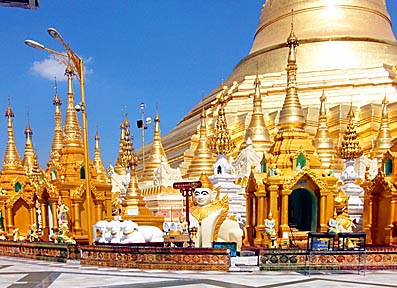Tailor Made Holidays with our travel experts
We'll do our best to call you within 48h

What the Legend Says
The pagoda is believed to have the relics of four previous Buddhas of the current kalpa. The relics are eight hair strands from Gautama’s head, Koṇāgamana’s water filler, a piece of Kassapa’s robe, and Kakusandha’s staff. According to folklore, two merchant brothers named Bhallika and Taphussa from what is currently known as Afghanistan met the Lord Gautama Buddha and he gave them eight strands of his hair to be enshrined in Myanmar. They traveled to Myanmar and found Singuttara Hill, which had been believed to contain the relics of other Buddhas. When King Okkalapa opened the golden casket carrying the hair strands, many incredible and supernatural things happened.
The relics were placed in a chamber, which was then covered with a golden slab. After that, seven stupas made of gold, silver, tin, copper, lead, marble, and iron-brick respectively were built over it. The legend also says that Indian emperor Asoka rebuilt the stupa after it was ruined.
Construction & Reconstruction
According to historical and archeological records, the Mon people built the pagoda sometimes between the 6th and 10th centuries. However, legend claims the construction time dates back to 2,600 years ago, making it the oldest Buddhist stupa in the world. The stupa was in a ruined state until the 14th century. King Binnya U (1323-1384) repaired it and made it an 18-meter (59-foot) structure. It was increased to the height of 40-meter (131-foot) a century later by Queen Binnya Thau (1453-1472).
It became Myanmar’s most famous Buddhist pilgrimage site by the beginning of the 16th century. A series of earthquakes caused much damage to it and a 1768 quake did the worst damage by bringing down the top of the stupa. It was rebuilt to the current height of 99-meter (325-foot) by King Hsinbyushin. In 1931, it suffered a disastrous fire and the main stupa was completely refurbished after a minor earthquake in 1970.
Layout of the Pagoda
The base of the pagoda is built with gold plated bricks. Other structures that are built over the base respectively are a terrace, a bell-shaped part, a turban, an inverted almsbowl, upright lotus petals, a banana bud, and an umbrella crown, which is adorned with rubies and diamonds.
Four covered walkways (zaungdan) lead to the main terrace. A pair of 9-meter tall chinthe is flanked at the entrance of each walkway. The entrances have the facility of elevators and escalators for the visitors who do not want to climb the steps. The pagoda is full of sacred artifacts, relics, structures, and things related to Buddhist religion. Apart from relishing the beauty of the wonderful architecture and the precious stones of the pagoda, you can visit the place to get familiar with the great teachings of the Buddha.